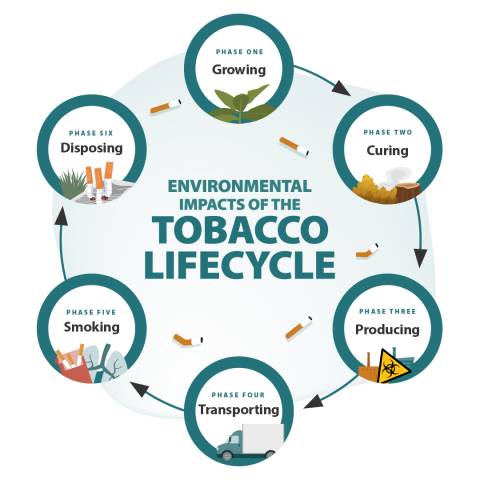You are here
Global Tobacco Surveillance Protects People And The Environment
Tobacco use is the single most preventable cause of illness and death worldwide, and may kill up to one billion people by the end of this century. If current rates continue, 75 percent of those deaths are expected to occur in low-and-middle-income countries (LMICs). Along with its burden on human health, tobacco use imposes environmental harm.
To raise awareness of tobacco’s impact on the environment, on May 31, the World Health Organization (WHO) launched a global campaign, “Tobacco: Threat to Our Environment,” in honor of World No Tobacco Day. The campaign calls on governments, policy makers and partners to amplify tobacco’s harmful impact and advocate for stronger policies on tobacco control to protect people and the planet. On this World No Tobacco Day, the CDC Foundation is grateful to play a role in helping countries to take action to reduce tobacco use to improve lives and protect the environment. From cultivation to distribution, the whole life cycle of tobacco negatively impacts the environment.

Each year, over three million hectares of land are destroyed for tobacco cultivation; and, tobacco corporations release the equivalent of 84 megatons of carbon dioxide through tobacco cultivation, manufacturing, distribution and logistics. Once in the hands of consumers, tobacco smoke is released into the environment and contributes to ambient air pollution. Additionally, third-hand smoke is formed when residue from secondhand smoke accumulates in environments where tobacco has been smoked, ultimately polluting landfills and leaching into groundwater. The negative impacts of increased land and water use, deforestation, greenhouse gas emissions and pollution from post-consumer waste, like third-hand smoke and cigarette butts, are disproportionately concentrated in LMICs.
Surveillance and monitoring help scientists and policy makers better understand the environmental impacts of tobacco use. As a partner in the Bloomberg Initiative to Reduce Tobacco Use, the CDC Foundation builds public-private partnerships to enhance governments’ capacity for tobacco control surveillance and monitoring. In collaboration with the Centers for Disease Control and Prevention (CDC), WHO and other international partners, the CDC Foundation works with countries to implement components of the Global Tobacco Surveillance System (GTSS), which is comprised of the Global Adult Tobacco Survey (GATS), the Global Youth Tobacco Survey (GYTS), Tobacco Questions for Surveys (TQS) and Tobacco Questions for Surveys of Youth (TQS-Youth). Countries can use the data gathered from GTSS to develop policies and priorities to protect people and the environment from the harmful effects of tobacco.
The CDC Foundation is also continuing to expand its space in virtual learning environments to share the harmful effects of tobacco use, with the recent launch of a new GTSS Academy e-learning course, Global Tobacco Control in a Changing Product Landscape. The course aims to increase public health professionals’ awareness of global tobacco use and control in a changing landscape and provide resources for optimizing global tobacco control and prevention for new and emerging products. The course also includes a lesson titled Environmental Impacts, which highlights the damage of tobacco use to the environment, from the cultivation of tobacco to tobacco product disposal.
Tobacco’s impact on human health and the environment is devastating. It is essential for governments, policy makers and partners to support LMICs in curbing the tobacco epidemic to achieve better environmental and economic prosperity.
